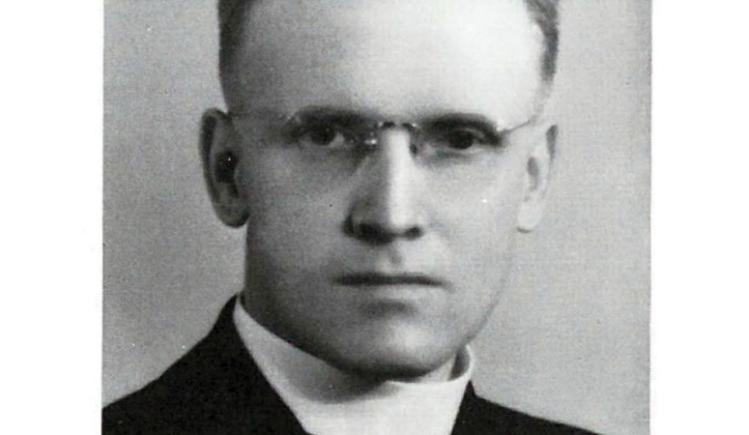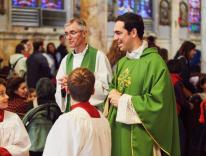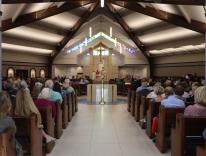
In his day, Fr. Charles Dismas Clark, SJ, was known as the Hoodlum Priest. When he died, the New York Times ran a thirteen-inch obituary, plus a photo of the rail-thin priest. The two-column headline read, “Rev. C. Dismas Clark, 62, Dies; A Pastor of 3,500 Ex-Convicts.”
Clark was one of thirteen children, raised in Illinois; his father was a coal miner. “I was a tough kid raised in a tough environment,” the New York Times reported he had said. “I could easily have become a criminal myself.” Instead, when he was seventeen, he met a priest who inspired him to his vocation. He was ordained in 1932 and began teaching high school. During World War II he served as an Army chaplain, and when the war ended his province assigned him to retreats and missions.
Clark’s work took him to the Missouri State Penitentiary, where he was appalled at the inmates’ condition. St. Louis judge D. W. Fitzgibbons invited Clark to his courtroom to witness “the hopelessness and suffering of the offenders brought before the bench.” Clark understood that the “cons” had little support. “Have you ever seen a man’s eyes empty of hope?”—that question became his motivation and mantra whenever he made an appeal for funds or compassion.
At first, convicts thought Clark was another do-gooder with little conviction behind his preaching. But he delivered on his promises and earned their respect. He gave them money to buy cigarettes—provided they shared with each other—and came back every week, while other chaplains visited once a month, if that. Prison officials were stunned when inmates gave up their movie night to attend Clark’s homilies.
In the mid-1950s, while hanging around courtrooms, Clark met Morris Shenker, a prominent St. Louis attorney. Shenker was Jimmy Hoffa’s personal lawyer and part owner of the Dunes Hotel and Casino, linked to Vegas mobsters. Clark and Shenker agreed that parolees and flat-timers—convicts who had served their sentences—were less likely to return to crime if there was a place where “homeless, powerless men could have lodging, food, clothes, and a helping hand until they got a job.” They teamed up—an Irish Catholic Jesuit and an immigrant Russian Jew. The priest, determined to open a halfway house named after the “good thief” who died beside Christ, changed his name from Charles W. Clark to C. Dismas Clark.
In August 1959 he received permission from his province to establish a halfway house, and he bought an empty public school building with financial backing from Shenker. Dismas House opened November 1. The publicity was not all favorable. Many thought Clark was interfering with the judicial system and disapproved of his ties with Shenker and Hoffa. Also, Clark openly criticized the church and society for their attitude toward convicted men. His notoriety peaked when United Artists produced The Hoodlum Priest, with Don Murray in the title role. The movie premiered in St. Louis in February 1961. Reviews were mixed (Commonweal called it a “remarkable little film”). Clark’s work went on.
I followed all this with some interest, since I had crossed paths with Clark in 1952. I was not a convict or parolee, but a fifteen-year-old beginning my second year in an all-boys Catholic high school. That year started with a one-day retreat in the school gym. Folding chairs for students faced a raised platform with a life-size crucifix. Beside it stood Fr. Clark, who looked frail until he began to talk. Fire and brimstone are inadequate to describe his delivery. He knew he was addressing boys whose every day was a battle with impure thoughts and actions. Clark minced no words. He made sure we understood that every one of our sins was a hammer blow, driving the nails deeper into Christ on the cross. “This man died for you!” he bellowed. He heard confessions afterward, and inside the confessional I sobbed like a scolded two-year-old.
For the next ten years I watched Clark continue his crusade of redemption through work and spreading the Gospel of God’s love. He labored tirelessly, smoked endlessly, and developed a heart ailment. At sixty-two he suffered a fatal heart attack. By the time of his death on August 15, 1963, more than two thousand men had passed through Dismas House, and they reported that an astonishing 95 percent were rehabilitated, never returning to a life of crime. Hundreds more, still in prison, were deeply affected by the man known as the Hoodlum Priest. Tough men cried that day.
Please email comments to [email protected] and join the conversation on our Facebook page.
Share
Previous Story
Bookmarks | Consumed By Ideas
Next Story
Poem | Caterpillar


